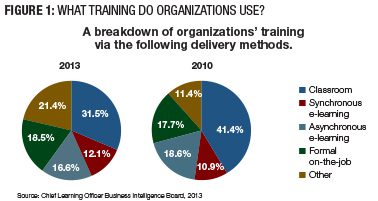Content, audience, environment and available technology each play a role in how learning is delivered, and all of those continue to evolve. However, despite volatility, survey results from the Chief Learning Officer magazine Business Intelligence Board (BIB) suggest that organizations are getting more sophisticated in their modality choice. Asynchronous e-learning is increasingly seen as the preferred delivery method to train a group with varied skill levels, and classroom remains the most significant form of training, in spite of alternatives.
Every other month, market intelligence firm IDC administers a Web-based survey to the BIB on a variety of topics to gauge the issues, opportunities and attitudes that affect a senior learning executive. This month offers an annual look into learning modalities and how they are evolving.
Last year, this survey showed that while CLOs shifted their emphasis away from classroom-based, instructor-led training (ILT) toward e-learning, the overall portfolio hasn’t changed very much. This year’s survey continues to show that the future includes more emphasis on social learning, increased use of mobile technologies and a continued refinement of how and when to use e-learning.
Economy Driving Small Shifts
CLOs are using the full range of options for learning delivery. Consistent with previous surveys, classroom training is used more often, though the combination of synchronous and asynchronous e-learning continues to represent a growing modality.
This year’s results show a decline in the use of classroom-based training since 2010, a small increase in synchronous and asynchronous e-learning and a large gain in “other” (Figure 1). The decreased emphasis on classroom training and a large increase in other suggests enterprises are bypassing the now-traditional e-learning options and exploring other experiences such as performance support or peer-based training.

Further, mobile devices were used for only a small amount of training — about as often as video-based instruction. On the other hand, a significant number of organizations are leveraging formal on-the-job training, though its use hasn’t changed much in the past couple of years.
CLOs adjust their use of various modalities primarily because of the modalities’ effectiveness in a particular environment, but cost and convenience also play a major role. Organizations that reduced their classroom-based ILT were most often driven by cost.
During the coming year, CLOs expect classroom-based ILT to continue to represent a declining portion of the delivery portfolio, primarily because of cost. Both synchronous and asynchronous e-learning will gain portfolio share in most enterprises in reaction to continued pressure on development budgets and greater flexibility in scheduling and delivery.
Also gaining in interest is the use of simulations. While representing a modest share of the overall delivery portfolio, CLOs seem to want to see that share increase. Learning leaders are also expressing an interest in expanding the use of smart mobile technologies in training delivery; however, this interest has been seen with little execution before.
Match the Message to the Medium
CLOs are increasingly trying to apply the right delivery option for the content, audience and environment. While they continue to prefer one modality over another for particular content, they often believe their choice represents the most appropriate method for the learner.
One way the message can be defined is by content type: business skills courses or IT content. Preferences for delivery modality by content domain have changed little since 2007. A greater percentage of CLOs describe classroom-based ILT (C-ILT) as the primary delivery modality for business skills training, at 58 percent, than describe C-ILT as primary for IT skills training, at 32 percent (Figure 2). But the magnitude of the preference for C-ILT is declining overall. Compliance training is the only learning content domain where C-ILT is not considered the primary delivery modality and where most enterprises prefer self-paced e-learning, at 62 percent, to C-ILT, at 15 percent. For new-hire training, the preference for C-ILT, at 52 percent, is closely followed by self-paced e-learning, at 13 percent, and instructor-led e-learning and on-the-job instruction, both at about 10 percent.

Despite recent and continued emphasis on social media to support learning, the most significant types of informal learning aren’t technology-based. On-the-job experiences, mentoring, discussions and networking with other professionals are traditional, low-tech forms of instruction and are considered among the most important forms of informal learning.
Business skills courses largely focus on soft skills and lend themselves to face-to-face experiences with instructors and peers. CLOs see the value of classroom instruction when it is an appropriate method for the content to be conveyed.
E-learning, however, is consistently seen as an increasingly appropriate method to deliver IT skills content. About 40 percent of enterprises select at least one form of e-learning as the primary delivery method for IT skills training, compared to 28 percent that selected it as their primary modality for business skills training. In 2010, only 15 percent considered e-learning a primary delivery modality for business skills courses.
Current instructional practices for IT skills tend to emphasize independent study and practice over shared learning and group work. At the same time, research and practice suggests that teaching technology using technology results in effective instruction more often than teaching non-technology content using technology. As collaborative technologies make their way more completely in online instructional modalities, learning leaders likely will observe increased value and use of collaborative e-learning experiences when teaching IT and business skills, reflecting the trend in work itself.
In every organization, the training team has to account for a mix of skill levels among its workers. Similar to responses from previous studies, text-based training and formal on-the-job training are considered more effective with lower-skilled workers, and e-learning, both synchronous and asynchronous, is considered more effective for higher-skilled employees (Figure 3). Because asynchronous e-learning is consumed at the student’s pace, it is preferred as the modality for higher-skilled employees and where scheduling the course or the students is a priority.

Portable technologies — smartphones, MP3 players and CD-ROM-based courses — are considered to have better results with higher-skilled employees, but experience has shown CLOs they are also more effective with more junior-level employees.
Even though survey results imply different audience types react differently to different content types, specific combinations of content, audience and environment can make any delivery modality appropriate. CLOs must consider the unique circumstances behind a training intervention and determine the most appropriate combination of content and delivery modality.
What’s Going to Change?
CLOs observed three shifts in delivery: mobile, modular and social. Mobile learning, while not strongly reflected in the current paradigm, appears as a beacon of opportunity to many CLOs. “Mobile technology will increase with the creation of short learning bursts. Similar to tweeting, learning will adapt to create small yet relevant learning bursts,” predicts one CLO.
Another sees a more moderate pace: “More mobile device (i.e. tablet PC and smartphone) delivery of training materials.” A third CLO thinks mobile goes beyond that: “Mobile will become the dominant form of delivery. This is due to the proliferation of mobile and tablet devices, making it easier for corporations to pass that expenditure on to the employee.”
A consistent theme in both interviews and survey comments is the value of small, relevant content. One CLO predicted, “to deliver training in small chunks, incorporated as part of a program so to be prescriptive” is the wave of the future. This is because “shorter modules allow for more focused and concentrated learning chunks and greater engagement,” several CLOs said. Another CLO adds an element of “pull,” which was echoed by others: “I see training becoming more of a self-serve collaborative venue because of the higher technical expertise and habits of the new generation of employees.”
On the other hand, some see modular as an approach which becomes more “push:” “Modular, real-time, self-regulated and ‘subscription based’ or push learning technologies — what I need based on my job, when I need it,” one learning leader said.
Social learning, in many forms, appears to be a way to adopt relevant, cost-effective training while the enterprise still maintains a somewhat active role in development and leveraging more traditional self-directed learning.
“More social learning efforts, connecting experts with learners real-time as learning is happening on the job,” said one CLO.
Another CLO reflected on the more radical change in the relationship between student and instructor: “More social learning, communities of practice online, the resurgence of more formal coaching and mentoring skills.” Some see the impact of social as part of the broader trend: “Much more collaborative and less formal. [Including] less about … delivering training and more about real-life approaches to learning and … performance on the job.” This theme was repeated several times as CLOs believe learning will “become less about the teacher/student model and more about active learning and learning by doing.”
But the reality of the slow-growth economy continues to impact decisions: “As time and resources get harder to acquire for training, there will be more e-learning methods used to provide less costly and more readily available training,” one learning leader said.
However, this shift is not without risk. According to one CLO, “The use of various types of e-learning will require a robust plan for assisting people to transfer their learning to the work environment.” More often, CLOs see cost and convenience driving the shift to e-learning: “I see our organization moving to more e-learning strategies, both instructor-led and self-paced. This is due to the globalization of the organization. It will be more effective, cost less and [be more] efficient to train people in many different locations at once and have learning available on demand,” said another CLO.
Cushing Anderson is program director for learning services at market intelligence firm IDC. He can be reached at editor@CLOmedia.com.















